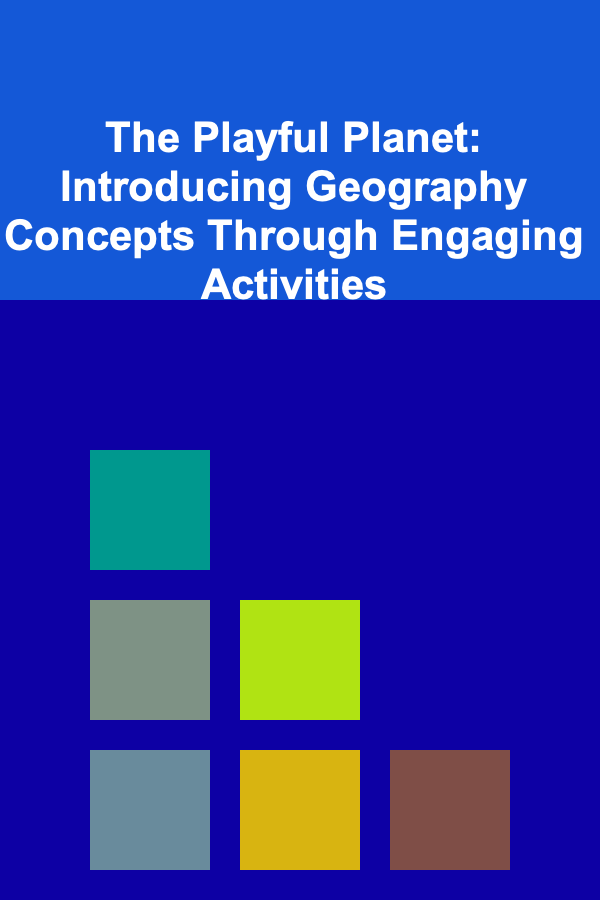
The Playful Planet: Introducing Geography Concepts Through Engaging Activities
ebook include PDF & Audio bundle (Micro Guide)
$12.99$11.99
Limited Time Offer! Order within the next:

Humanity's innate curiosity about the world is as old as our very existence. From the earliest nomadic tribes tracing their paths across vast plains to modern astronauts gazing upon the blue marble, the desire to understand where we are, how places connect, and what makes each location unique has driven exploration, innovation, and cultural exchange. Geography, at its heart, is the study of these very questions -- not just memorizing names on a map, but grasping the intricate relationships between physical landscapes, human societies, and the environment. Yet, for many, the mere mention of "geography" conjures images of tedious memorization, dusty atlases, and abstract concepts that feel disconnected from lived experience. This perception, unfortunately, often stems from traditional teaching methodologies that fail to tap into the natural curiosity and exploratory spirit inherent in every child.
The profound truth, however, is that geography is an inherently playful subject. It's about discovery, adventure, building, imagining, and interacting with the world around us. Children, by their very nature, are budding geographers. They build forts in the backyard, mapping out their territories; they draw treasure maps, understanding scale and symbols intuitively; they ask "where does the rain come from?" or "why is that mountain so big?"; they role-play journeys to far-off lands, internalizing cultural differences and physical distances. This article posits that by intentionally harnessing the power of play, educators and parents can transform geography from a dry, academic exercise into a vibrant, engaging, and deeply meaningful exploration that lays a robust foundation for lifelong learning and global citizenship. We will delve into the pedagogical underpinnings of play-based learning, explore a myriad of practical, age-appropriate activities spanning various core geographical concepts, and discuss how to cultivate an environment where geographical understanding flourishes naturally through joyous interaction with the world.
The Pedagogical Imperative: Why Play is Paramount for Geography Education
To understand why play is so critical for introducing geography, we must first appreciate the profound impact of play on cognitive, social, emotional, and physical development. Play is not merely frivolous recreation; it is the fundamental mechanism through which children make sense of their world, develop essential skills, and consolidate knowledge. In the context of geography, play offers a dynamic, multi-sensory, and intrinsically motivating pathway to understanding concepts that might otherwise remain abstract and inert.
Constructivism and Experiential Learning: Building Knowledge Through Doing
At the core of play-based learning lies the philosophy of constructivism, championed by theorists like Jean Piaget and Lev Vygotsky. Constructivism posits that learners actively construct their own understanding and knowledge of the world through experiencing and reflecting on those experiences. They don't passively receive information but build mental models and theories through interaction. Geography, with its emphasis on spatial relationships, environmental processes, and human interactions, is perfectly suited for a constructivist approach. When children build a miniature river system in a sandbox, they are not just playing; they are actively constructing an understanding of erosion, water flow, and landform creation. When they navigate a treasure hunt using a self-drawn map, they are building a practical understanding of spatial reasoning, orientation, and symbolic representation.
Experiential learning, a key tenet of constructivism, emphasizes learning by doing. David Kolb's model of experiential learning cycles through concrete experience, reflective observation, abstract conceptualization, and active experimentation. Play inherently supports this cycle. A child's concrete experience of splashing in a puddle can lead to reflective observation about its depth and spread, abstract conceptualization about the water cycle or topography, and active experimentation by building dams or channels. This hands-on engagement fosters deeper comprehension and retention than passive listening or rote memorization.
Inquiry-Based Learning: Fostering Curiosity and Critical Thinking
Play naturally lends itself to inquiry-based learning, where children are encouraged to ask questions, investigate phenomena, and discover answers for themselves. Rather than being told facts about climate zones, a child engaged in a "weather station" project will organically ask, "Why is it colder here than there?" or "How much rain did we get today?" These questions become the fuel for further exploration, leading to a more robust understanding of meteorological patterns and their geographical distribution. This approach cultivates critical thinking skills, problem-solving abilities, and a lifelong love of learning, moving beyond superficial knowledge to genuine comprehension.
Developmental Appropriateness: Tailoring Concepts to Capacity
A significant advantage of play is its inherent flexibility in adapting to various developmental stages. Early childhood geography focuses on immediate surroundings -- the classroom, the home, the neighborhood -- building foundational spatial awareness. As children mature, play can introduce more complex concepts like global landforms, climate zones, and cultural diversity, always grounding these abstract ideas in concrete, playful experiences. For instance, a toddler might understand "near" and "far" by playing hide-and-seek, while an older child might grasp "scale" by comparing a small model to a large map. Play allows educators to scaffold learning, introducing concepts at the precise moment a child is ready to absorb them.
Intrinsic Motivation and Emotional Engagement
Perhaps the most powerful argument for play in education is its ability to foster intrinsic motivation. When learning is enjoyable, children are more likely to engage deeply, persist through challenges, and internalize information. Play reduces anxiety and makes learning feel less like work and more like an exciting adventure. When children laugh while building a mountain range out of playdough or excitedly point out their city on a globe, they are forming positive emotional connections with geography. These positive associations are crucial for developing a lifelong interest in the subject, leading to a greater appreciation of our interconnected world.
Core Geography Concepts and Playful Pathways to Understanding
Geography is a vast and multifaceted discipline. By breaking it down into core concepts, we can identify specific playful activities that illuminate each one. The beauty of play is that a single activity can often touch upon multiple concepts simultaneously, creating a rich, integrated learning experience.
1. Spatial Awareness and Orientation: Knowing Where You Are and Where You're Going
Before children can understand the vastness of continents, they must first grasp their own position in space and how objects relate to one another. Spatial awareness is the bedrock of all geographical understanding.
Concepts Introduced:
- Relative Position: Near/far, over/under, beside/between, inside/outside.
- Cardinal Directions: North, South, East, West (initially simplified, then formalized).
- Egocentric vs. Allocentric Perspective: Understanding position from one's own viewpoint versus an external, objective viewpoint.
- Route Following & Planning: Navigating from one point to another.
Playful Pathways:
- Obstacle Courses & Scavenger Hunts: Set up a simple obstacle course in a room or yard. Give verbal directions using positional words ("Go over the blanket, under the chair, around the table"). For scavenger hunts, hide objects and give clues like "Look behind the big tree," or "The treasure is under the red swing." As children mature, introduce cardinal directions: "Go three steps North, then five steps East." This builds practical understanding of directionality and following instructions.
- "Simon Says" with Movement & Position: "Simon Says, put your hands over your head!" or "Simon Says, stand beside the door!" This reinforces positional vocabulary in an active, fun way.
- Drawing Maps of Familiar Spaces: Encourage children to draw maps of their bedroom, the classroom, their backyard, or a favorite playground. Start with simple "treasure maps" where they mark where a toy is hidden. Discuss symbols ("What does this squiggle mean?"). This is a powerful transition from egocentric to allocentric perspective as they try to represent a space from an overhead view.
- Block Play & Miniature Worlds: Provide a variety of blocks, small figures, and vehicles. Children will naturally create towns, roads, and landscapes. As they build, encourage them to describe their creations using spatial language: "The car is driving on the road next to the house," or "The tower is taller than the tree." This allows them to physically construct and manipulate spatial relationships.
- Nature Walks with Directional Focus: While on a walk, point out landmarks and ask, "Is the park to our left or right?" or "Which way is North from here?" Use a simple compass to identify directions, making it a real-world application.
2. Maps and Globes: Representing Our World
Maps and globes are the fundamental tools of geography. Introducing them through play demystifies their abstract nature and reveals their power as navigational and informational instruments.
Concepts Introduced:
- Representation: That a drawing or model can stand for a real place.
- Scale: That distances on a map correspond to larger distances in reality.
- Symbols & Legends: That specific icons represent real-world features (roads, rivers, mountains).
- Projection: The challenge of representing a 3D sphere on a 2D surface (simplified for younger learners).
- Grid Systems: Basic understanding of how lines help locate places (e.g., street names, simple coordinates).
Playful Pathways:
- "Giant Map" Creation: On a large sheet of paper or cardboard, draw a simple map of a room or the schoolyard. Use large, simple symbols. Have children walk or drive toy cars along the "roads" on the map, then find the corresponding real-world locations. This bridges the gap between the abstract map and the concrete environment.
- 3D Relief Maps: Use salt dough, clay, or even dirt in a sandbox to create a physical map. Children can sculpt mountains, carve rivers, and add small blocks for buildings. This makes the concept of elevation and landforms tangible and directly relates the 3D world to its 2D representation.
- Puzzle Maps: Invest in or create continent/country puzzle maps. These hands-on puzzles allow children to physically manipulate the shapes of landmasses, learning their names and relative positions without rote memorization.
- "Globe Trotters" Game: Spin a globe and randomly point to a location. Have children identify the continent, ocean, or country. Add a playful element by having them share a fun fact about that place or imagine what it would be like to visit.
- "Post Office" Role-Play: Set up a play post office. Children write or draw "letters" to friends or family (real or imaginary) in different cities or countries. Use real maps or Google Maps to "route" their letters, discussing how addresses and zip codes help locate places.
- Map Scavenger Hunt with Symbols: Provide a simplified map with a legend. Hide "treasures" (e.g., small toys) in places marked on the map by symbols (e.g., a tree symbol for "under a plant," a house symbol for "near a dollhouse"). Children use the legend to find the treasures.
3. Landforms and Water Bodies: Shaping the Earth's Surface
Understanding the diverse features of our planet -- mountains, rivers, deserts, oceans -- is fundamental to physical geography. Play offers tactile, visual, and imaginative ways to explore these concepts.
Concepts Introduced:
- Major Landforms: Mountains, valleys, plains, plateaus, hills, deserts, coasts, islands.
- Major Water Bodies: Oceans, seas, rivers, lakes, waterfalls.
- Geological Processes (simplified): Erosion, deposition, weathering, plate tectonics (very basic introduction).
- Interconnectedness: How landforms and water bodies influence each other and human life.
Playful Pathways:
- Sensory Bins & Trays: Create themed sensory bins. A "desert" bin might have sand, small rocks, plastic cacti. A "mountain" bin could have small stones, crumpled paper, and green fabric. A "ocean" bin could contain blue water, sand, seashells, and toy marine animals. Children can explore textures, shapes, and imagine landscapes.
- Landform Building with Playdough/Clay/Mud: Provide plenty of malleable materials. Challenge children to build a volcano, a river flowing through a valley, a towering mountain, or a flat plain. Encourage them to explain their creations. Add water to simulate rivers or rain, observing how it interacts with the landforms.
- River System Experimentation: In a sandbox or a large tub, create a miniature landscape with slopes. Use a watering can or hose to pour water, observing how it forms channels, creates deltas, and erodes the "land." This is a powerful, hands-on demonstration of hydrological processes.
- Landscape Painting & Drawing: Provide art supplies and encourage children to draw or paint different landscapes they've seen or imagined -- a snowy mountain range, a winding river, a vast ocean, or a sandy desert. Discuss the colors and textures associated with each.
- Storytelling & Dramatic Play: Read books about adventurers exploring different landforms (e.g., climbing Mount Everest, sailing across an ocean, trekking through a jungle). Then, encourage children to create their own "adventure stories" using props and costumes, role-playing journeys through imaginary (or real) landscapes.
- "Landform Charades": Act out different landforms or water bodies, with others guessing. This encourages kinesthetic learning and reinforces vocabulary.
4. Climate and Weather: The Earth's Atmospheric Dance
Understanding weather patterns and climate zones helps children grasp the diversity of environments across the globe and their impact on life.
Concepts Introduced:
- Basic Weather Elements: Temperature, precipitation (rain, snow, hail), wind, clouds, sun.
- Seasons: The cycle of changes throughout the year.
- Climate Zones (simplified): General patterns of weather in different regions (e.g., hot desert, cold polar, temperate).
- Water Cycle (simplified): Evaporation, condensation, precipitation.
Playful Pathways:
- Build a "Weather Station": Create a simple weather station using everyday materials. A plastic bottle for a rain gauge, a pinwheel for wind direction, a thermometer to track temperature. Children can record observations on a chart, fostering data collection and pattern recognition.
- Cloud Gazing & Identification: Lie on the grass and watch the clouds. Discuss different cloud types (fluffy cumulus, wispy cirrus) and what they might tell us about the weather. Encourage children to imagine what shapes they see.
- Water Cycle in a Bag: A classic science experiment that is also highly geographical. Place some water and a few drops of blue food coloring in a sealed plastic bag, tape it to a sunny window. Observe condensation, "rain," and evaporation, visually representing the water cycle.
- "Climate Zone" Dress-Up & Role-Play: Provide various items of clothing (e.g., swimsuits, parkas, raincoats). Ask children to imagine they are visiting different climate zones (desert, arctic, rainforest, temperate) and choose appropriate attire. Discuss why people wear different clothes in different places and how climate influences lifestyle.
- Weather Themed Art: Paint or draw pictures representing different types of weather (stormy, sunny, snowy) or the four seasons. Discuss the characteristics of each.
- Create a "Weather Jar": Fill a jar with water and add shaving cream on top (clouds). Drop blue food coloring through the "clouds" to simulate rain. This provides a simple visual model of precipitation.
5. Human and Cultural Geography: People and Their Places
Geography is not just about physical features; it's also about people -- how they live, interact with their environment, and create cultures. Play is an excellent vehicle for fostering empathy, understanding diversity, and appreciating global interconnectedness.
Concepts Introduced:
- Population Distribution: Why people live where they do (urban vs. rural).
- Cultural Diversity: Different traditions, languages, food, clothing around the world.
- Human-Environment Interaction: How people adapt to and modify their environment.
- Resources & Trade: How people use resources and exchange goods.
- Global Citizenship: Understanding our place in the wider world and our responsibilities.
Playful Pathways:
- "Around the World" Cultural Exploration: Dedicate a week or a day to a specific country or culture. Listen to music, try simple crafts, learn a few words in a different language, or prepare a simple dish from that culture. This fosters appreciation for diversity.
- Build a Miniature City/Village: Using blocks, cardboard boxes, or craft materials, children can design and build their own miniature communities. Discuss where houses, schools, shops, parks, and roads should go. Why do people live close to certain amenities? This explores urban planning and infrastructure.
- "Global Market" Role-Play: Set up a pretend market where different "countries" (children or groups) have specific goods to "trade." Discuss what resources each country has and why they would want to trade for others. This introduces concepts of resources, trade, and interdependence.
- "Passport" & Travel Agency Play: Create simple "passports" for children. Role-play being travel agents planning trips to different countries. Use maps and globes to plan routes, discuss climates, and imagine cultural experiences. This reinforces mapping skills and broadens global awareness.
- Storytelling & Folktales from Around the World: Read traditional stories, myths, and folktales from diverse cultures. Discuss the settings, characters, and how the environment might have shaped the story or culture. Encourage children to retell or create their own stories.
- Local Community Exploration: Go on walks around the neighborhood. Identify different types of buildings (residential, commercial, public), infrastructure (roads, bridges, power lines), and natural features (parks, rivers). Discuss how the community is organized and how people use its spaces.
6. Environmental Geography and Sustainability: Our Role as Stewards of the Planet
As geographical understanding deepens, it naturally leads to concepts of environmental responsibility and sustainability. Play can make abstract environmental challenges tangible and empower children to be part of the solution.
Concepts Introduced:
- Ecosystems: Basic understanding of interconnected living things and their environment.
- Natural Resources: Renewable vs. non-renewable resources.
- Pollution & Conservation: The impact of human activity and ways to protect the environment.
- Sustainability: Meeting present needs without compromising future generations.
Playful Pathways:
- Terrarium/Diorama Building: Create a small, self-contained ecosystem in a jar or clear container. Discuss how plants, soil, and moisture interact. Alternatively, build a diorama depicting a specific ecosystem (e.g., rainforest, desert) and discuss its unique characteristics and inhabitants.
- "Recycling Sort" Game: Provide a mix of recyclable and non-recyclable materials. Have children sort them into designated bins (paper, plastic, compost). Discuss why certain items can be recycled and the importance of reducing waste.
- Garden/Planting Projects: Plant seeds (indoors or outdoors) and care for them. Discuss where our food comes from, the importance of soil and water, and the concept of growth and life cycles. This connects children directly to natural processes and resource use.
- Nature Scavenger Hunts (Resource Focus): Go on a nature walk and look for examples of natural resources (e.g., wood from trees, water in a stream, sand). Discuss how humans use these resources and the importance of not overusing them.
- "Eco-Heroes" Role-Play: Children can role-play as "eco-heroes" or "environmental scientists" who are tasked with solving an imaginary environmental problem (e.g., a polluted river, too much waste). They can brainstorm solutions and act them out.
- Compost Bin Exploration: If feasible, start a small compost bin. Children can observe how food scraps and natural materials decompose, turning into rich soil, demonstrating natural cycles and waste reduction.
Integrating Resources and Technology for Enriched Play
While open-ended play with simple materials is paramount, various resources and technologies can significantly enhance and extend geographical learning through play.
Digital Tools: Bridging the Virtual and Real
- Google Earth/Google Maps: These are incredibly powerful tools. Children can "fly" anywhere in the world, explore street views, measure distances, and identify landmarks. Use it to "visit" places they've read about, see their own home from above, or plan imaginary journeys. This connects abstract map reading to real-world visuals.
- Educational Apps & Games: Many apps are designed to teach geography in an interactive way, such as "Stack the States," "World Atlas by National Geographic," or "Barefoot World Atlas." Look for those that encourage exploration, problem-solving, and a sense of discovery rather than just rote memorization.
- Virtual Field Trips: Many museums, national parks, and cultural sites offer virtual tours. These can provide immersive experiences of diverse geographical locations, landforms, and cultural heritage, especially when real-world trips are not possible.
- Documentaries & Videos: Age-appropriate documentaries (e.g., BBC Earth, National Geographic Kids) can visually bring remote places, diverse cultures, and complex geographical processes to life, sparking curiosity and providing context for play.
Physical Resources: Tangible Tools for Exploration
- Globes and Atlases: Essential tools. Ensure they are accessible. Encourage children to spin the globe, trace continents, and flip through atlases, noting colors, symbols, and labels.
- Wall Maps & Posters: Display large, colorful maps of the world, continents, and local areas. Refer to them frequently during play and discussions.
- Books (Fiction & Non-fiction): Picture books that transport children to different places, non-fiction books about landforms, animals in different habitats, or cultural traditions. Storytelling is a potent geographical tool.
- Construction Materials: Blocks (wooden, magnetic, LEGOs), playdough, clay, sand, water, natural loose parts (pebbles, leaves, sticks) are crucial for building, modeling, and sensory exploration.
- Art Supplies: Crayons, markers, paints, paper, cardboard for drawing maps, creating landscapes, designing flags, or illustrating cultural elements.
- Cultural Artifacts & Props: Items that represent different cultures (e.g., fabrics, simple musical instruments, cooking utensils, traditional clothing) can enrich dramatic play and cultural exploration.
- Compasses: Simple, child-friendly compasses for real-world directional activities.
Creating a Playful Geography Learning Environment
The success of play-based geography hinges not just on the activities themselves, but on the environment in which they occur. This includes both the physical space and the pedagogical approach of the adults involved.
The Physical Space: A Landscape for Exploration
- Dedicated Geography Corner/Area: Designate a space (even a small one) that is rich with geographical resources: globes, atlases, maps, relevant books, natural materials, and art supplies. Make these materials easily accessible to children.
- Outdoor Exploration: The ultimate geography classroom is the outdoors. Utilize playgrounds, local parks, forests, beaches, or even a backyard. These offer real-world examples of landforms, weather, ecosystems, and human impact. Encourage observation, collection of natural materials, and free exploration.
- Open-Ended Materials: Prioritize materials that can be used in multiple ways, fostering creativity and problem-solving. Sand, water, blocks, and clay are far more versatile than single-purpose toys.
- Display Children's Work: Showcase maps they've drawn, landforms they've built, weather charts they've created, or artwork inspired by different cultures. This validates their learning and encourages further engagement.
The Educator/Parent Role: The Facilitator of Discovery
In a play-based approach, the adult's role shifts from dispenser of facts to facilitator of discovery. This requires thoughtful observation, strategic questioning, and a willingness to follow the child's lead.
- Observe and Listen: Pay close attention to children's play. What are they interested in? What questions are they asking (explicitly or implicitly through their actions)? These observations inform how to extend their learning.
- Ask Open-Ended Questions: Instead of "What's this country called?", try "What do you notice about this part of the world?" or "How do you think people live here?" or "What might happen if this river dries up?" These questions encourage critical thinking and deeper exploration.
- Provide Provocations: Introduce new materials or ideas to spark curiosity. Place a new atlas on the table, bring in a bag of shells, or share a story about a faraway place. These "provocations" can ignite new lines of inquiry.
- Model Curiosity: Show genuine interest in geographical phenomena. Point out interesting cloud formations, discuss the route taken on a car trip, or wonder aloud about where a certain product came from. Your enthusiasm is contagious.
- Scaffold Learning: Offer just enough support to help children move to the next level of understanding without doing the work for them. This might mean providing a hint, suggesting a resource, or demonstrating a technique.
- Connect to Real-World Events: Discuss current events with geographical implications -- a natural disaster, an international sporting event, or cultural festivals. Locate these places on maps and talk about the people and environments involved.
- Embrace Mess and Exploration: Play, especially geographical play involving sand, water, paint, and mud, can be messy. Embrace it as a sign of deep engagement and rich learning. Provide tools for cleanup and focus on the learning process.
Assessment Through Play: Capturing Authentic Learning
Traditional tests may not capture the nuanced learning happening through play. Assessment in this context is ongoing and observational.
- Anecdotal Records: Keep brief notes on children's conversations, questions, and discoveries during play.
- Work Samples: Collect maps they've drawn, models they've built, or descriptions they've written.
- Photographs & Videos: Document their engagement with materials and activities.
- Conversations & Interviews: Engage children in discussions about their play, asking them to explain their thinking and understanding.
- Portfolios: Compile a collection of these various artifacts to demonstrate growth over time.
Challenges and Considerations in Play-Based Geography
While the benefits of play-based geography are immense, educators and parents may encounter challenges. Addressing these proactively can ensure a more effective and sustainable approach.
Balancing Structured and Unstructured Play
Not all play needs to be overtly "educational." Free, unstructured play is vital for creativity and self-direction. However, for introducing specific geography concepts, some intentionality and "provocation" from the adult can guide the play towards learning goals without diminishing its intrinsic value. The key is to avoid turning play into work. It's a delicate balance of providing rich resources and opportunities, observing, and then strategically stepping in to extend the learning when appropriate, rather than directing every moment.
Addressing Misconceptions
Children will naturally form misconceptions as they build their understanding. For instance, they might think the earth is flat or that all deserts are hot. Play provides a safe space for these misconceptions to emerge. Instead of correcting them directly, use guiding questions ("What makes you think that?", "What if we tried this?") or provide experiences that gently challenge their current understanding, allowing them to self-correct. For example, showing a globe and then flattening a piece of paper to demonstrate projection can help address the "flat earth" misconception better than simply stating facts.
Ensuring Depth Beyond Surface-Level Engagement
A common concern is that play-based learning might lead to superficial understanding. To ensure depth, constant reflection, questioning, and connection-making are crucial. Encourage children to articulate what they are doing and why. Provide opportunities for repetition and variation of themes. Connect new concepts to prior knowledge. For instance, after building a landform, ask how it relates to places they've seen in books or on a map. This iterative process deepens understanding over time.
Resource Limitations
Not all schools or homes have access to extensive geographical materials. However, much of play-based geography can be done with simple, readily available, or low-cost materials: sand, water, dirt, rocks, leaves, sticks, cardboard boxes, recycled materials, old newspapers, string, and basic art supplies. The most valuable resource is imagination and a willingness to explore the immediate environment.
Parent/Stakeholder Buy-In
In some educational settings, parents or administrators may be accustomed to more traditional, didactic methods. It's important to communicate the pedagogical rationale behind play-based geography, sharing research, showcasing student engagement, and explaining how play leads to deeper, more lasting learning outcomes. Inviting parents to observe or participate in play sessions can be highly effective.
Making it Inclusive for Diverse Learners
Play is inherently inclusive, as it allows for multiple entry points and ways of engaging. However, ensure that activities are accessible to children with diverse learning styles, abilities, and cultural backgrounds. Provide visual aids, tactile materials, opportunities for verbal and non-verbal expression, and culturally relevant content. Celebrate diverse perspectives and experiences in the geographical journey.
Conclusion: Cultivating Lifelong Geographers Through the Joy of Play
The journey of understanding our planet is one of the most exciting and essential explorations a child can undertake. Geography is not just a subject; it is a lens through which we comprehend the intricate tapestry of physical environments, human societies, and the profound interconnectedness of all life on Earth. When taught traditionally, it can feel like a dry collection of facts. But when embraced through the lens of play, geography transforms into a vibrant, hands-on adventure that captivates the imagination and fosters a lifelong sense of wonder.
By engaging with geographical concepts through building, exploring, imagining, and interacting, children construct a robust and nuanced understanding of their world. They develop critical spatial reasoning skills, learn to interpret complex information from maps and globes, grasp the forces that shape our planet, appreciate the rich tapestry of global cultures, and begin to understand their role as responsible stewards of the environment. From the simplest sandbox experiments that illuminate erosion to the intricate role-playing of international trade, every playful act is a step towards a deeper geographical literacy.
The imperative for educators and parents is clear: embrace play not as a supplement to learning, but as its very foundation. Create environments rich with possibilities, provide open-ended materials, observe with curiosity, question with intention, and facilitate with joy. In doing so, we don't just teach geography; we cultivate a generation of informed, empathetic, and globally aware citizens who are equipped not only to navigate the world but to understand, appreciate, and actively contribute to its future. The playful planet awaits, and within its boundless spaces, every child is a natural geographer, ready to explore, discover, and learn.

How to Increase Your Rental Property's Value
Read More
How to Save Money on Groceries Without Sacrificing Quality
Read More
How to Store Toys in a Way That Sparks Creativity
Read More
How to Interpret Ancient Fashion and Dress
Read More
How To Grasp the Concept of Quantum Decoherence
Read More
The Ultimate Guide to Streak-Free Cleaning with Microfiber Cloths
Read MoreOther Products

How to Increase Your Rental Property's Value
Read More
How to Save Money on Groceries Without Sacrificing Quality
Read More
How to Store Toys in a Way That Sparks Creativity
Read More
How to Interpret Ancient Fashion and Dress
Read More
How To Grasp the Concept of Quantum Decoherence
Read More